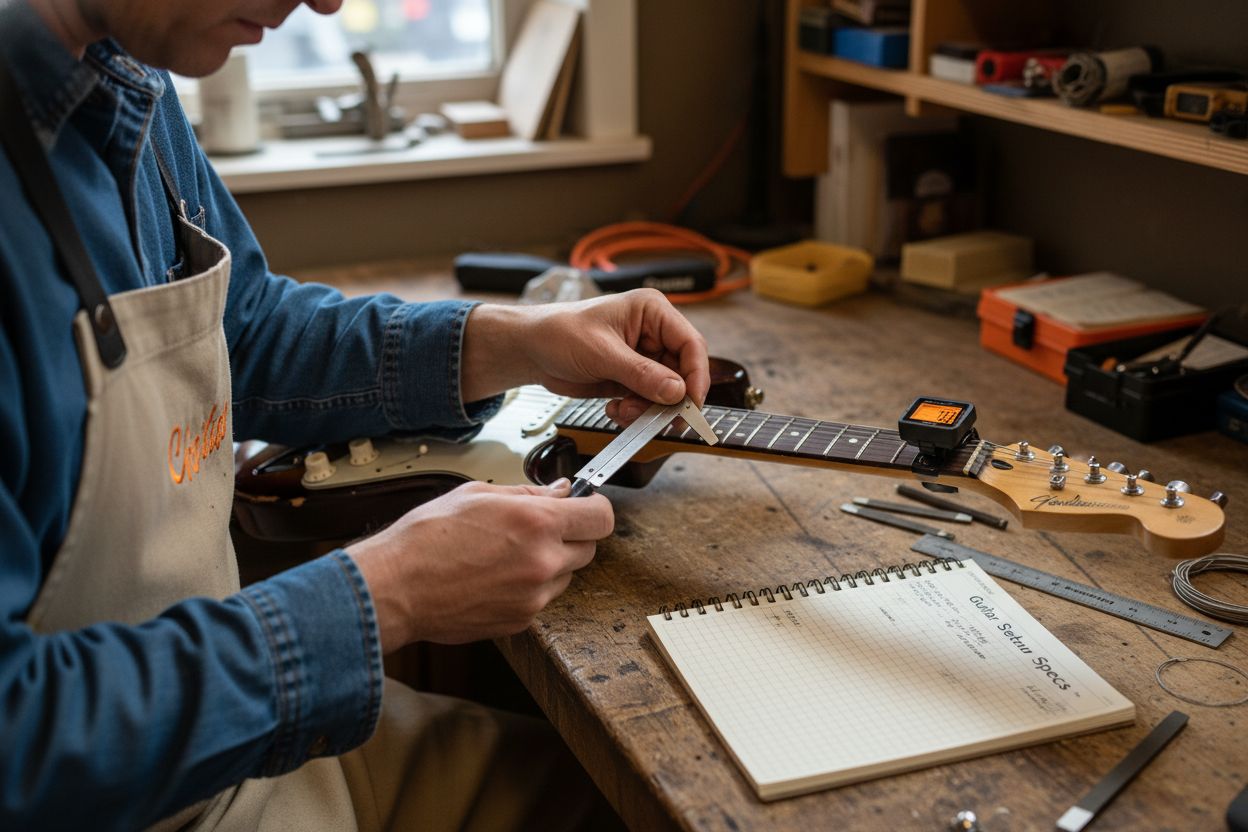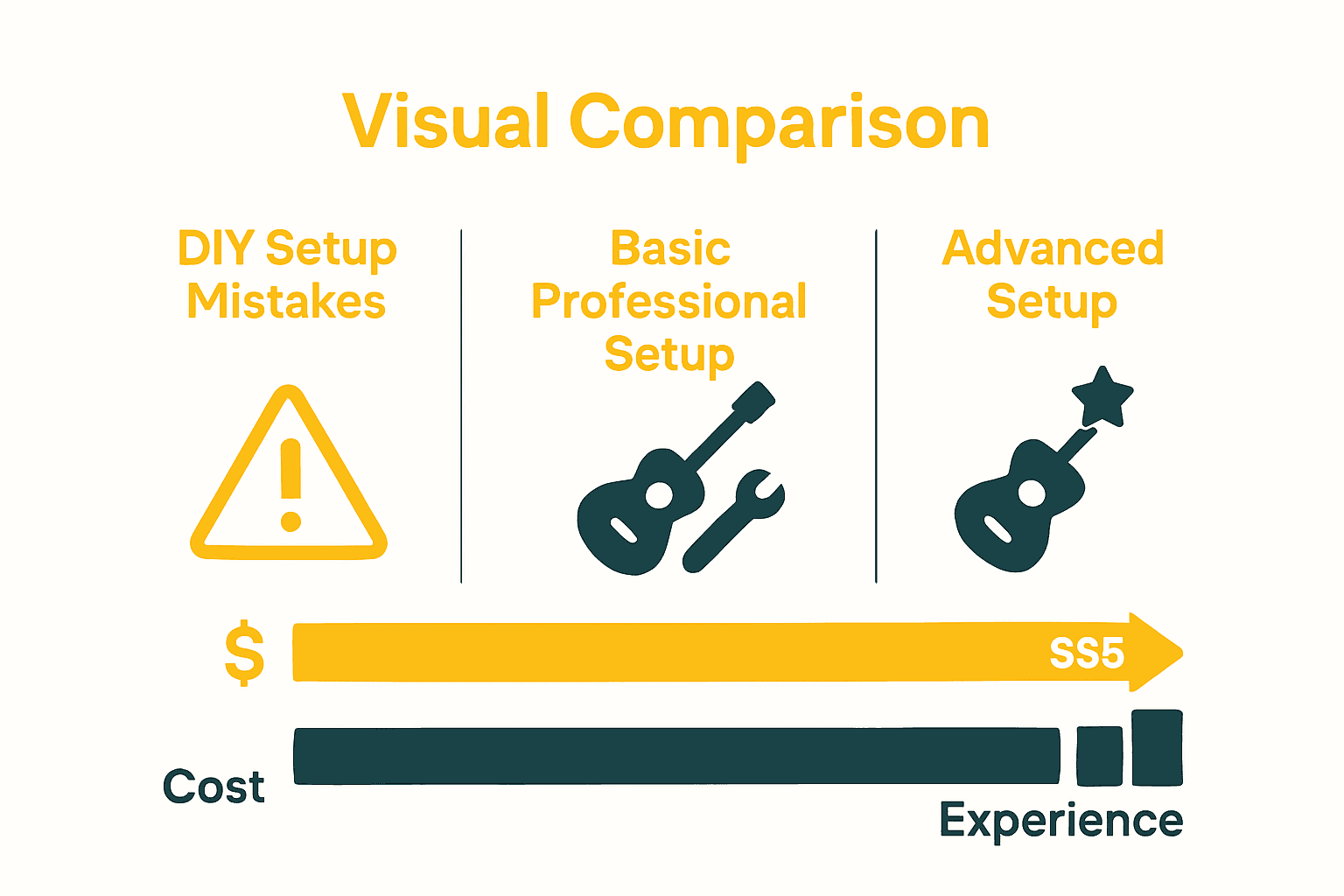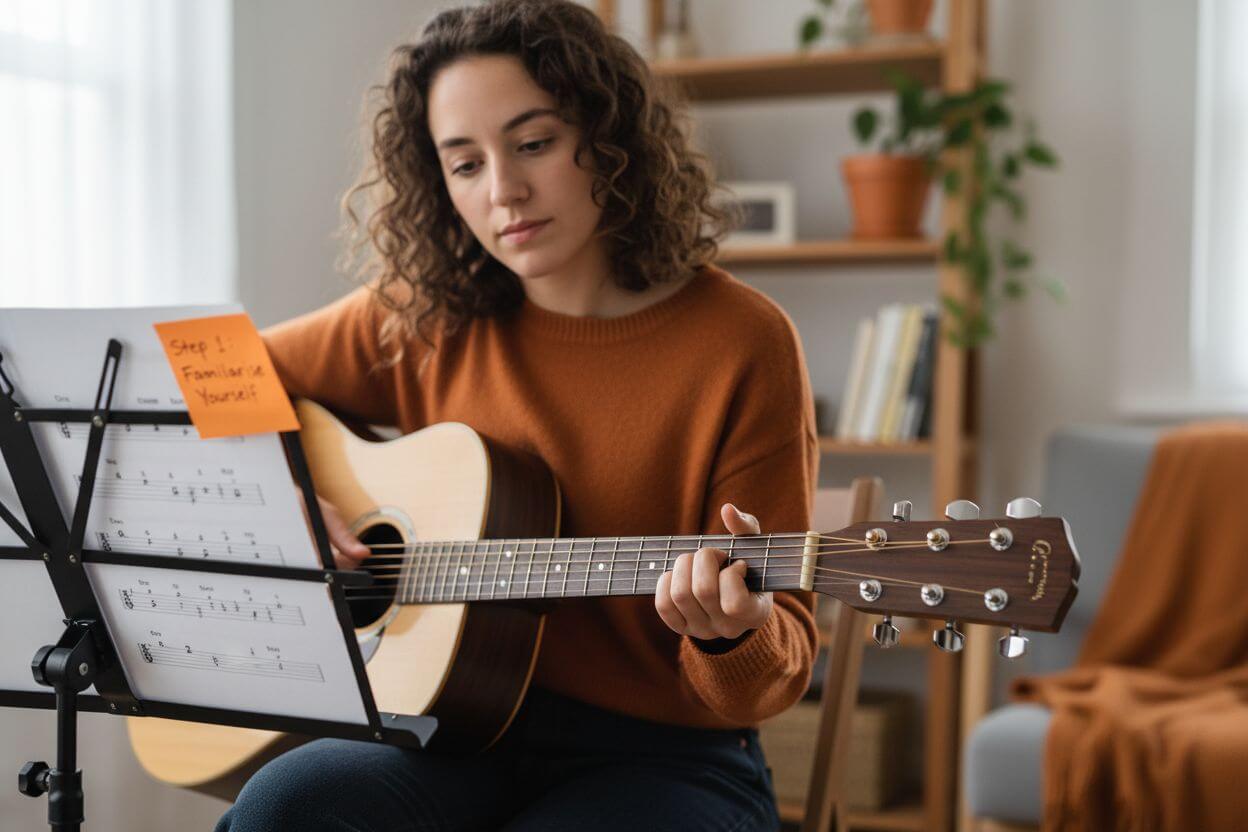Did you know that over 60 percent of new guitars leave the factory with playability issues that can hinder your technique and sound? A professional setup is the difference between a bland, frustrating experience and a guitar that truly responds to your touch. By understanding what a setup involves and how it can transform any guitar, you gain the power to unlock better comfort, tuning stability, and tone with every note.
Key Takeaways
| Point | Details |
|---|---|
| Professional Setup Importance | A meticulous guitar setup eliminates issues like fret buzz, optimizes action, and enhances overall tone and playability. |
| Standard Setup Steps | Key steps in a setup include neck adjustment, bridge calibration, nut slot adjustment, and intonation calibration, which must be executed in a specific order. |
| Cost Variations | Setup costs vary based on guitar type and complexity, with basic setups ranging from $50-$100 to advanced modifications costing $200-$500 or more. |
| Avoiding DIY Errors | Common DIY setup mistakes can lead to costly repairs; hiring a professional ensures that adjustments are done accurately, safeguarding the instrument’s performance. |
Table of Contents
- Defining A Professional Guitar Setup Process
- Essential Steps In A Standard Guitar Setup
- Setup Variations By Guitar Type And Style
- Key Playability And Tone Adjustments Explained
- Costs Involved And Avoiding Common Setup Mistakes
Defining a Professional Guitar Setup Process
A professional guitar setup represents a meticulous technical intervention designed to transform an instrument from merely functional to exceptional. According to research from Guitar Wizard, a comprehensive setup goes far beyond basic adjustments, focusing deeply on precise fret condition and levelling before making any other modifications.
The core purpose of a professional setup involves several critical objectives:
- Eliminating fret buzz and unwanted string vibration interference
- Optimising string action for comfortable playing experience
- Ensuring neck alignment and structural stability
- Maximising overall instrument playability and tone
Professional setups become essential because guitars frequently arrive from manufacturers with inherent manufacturing limitations. Guitar Advise research highlights that new instruments often suffer from high action and inconsistent fret conditions that can significantly compromise playing comfort and sound quality. These setups aren’t just cosmetic adjustments but strategic interventions that fundamentally improve an instrument’s performance.
Moreover, guitars aren’t static instruments. They continuously evolve through environmental changes, playing stress, and natural wear. Periodic professional setups help maintain an instrument’s structural integrity, ensuring that your guitar remains responsive, comfortable, and sounds precisely as intended. Learn more about signs your guitar needs a setup.
Essential Steps in a Standard Guitar Setup
A standard guitar setup follows a precise, sequential workflow designed to maximise instrument performance. According to research from Nashville Music Institute, the process involves four critical steps that must be executed systematically to ensure optimal playability and tuning stability.
The essential steps in a professional guitar setup include:
- Neck Adjustment: Setting neck relief using truss rod modification
- Bridge Adjustment: Calibrating string height and action
- Nut Slot Adjustment: Ensuring proper string placement and initial action
- Intonation Calibration: Fine-tuning string length for precise pitch across the fretboard
Sweetwater’s luthier research emphasises the importance of executing each step independently, preventing cascading adjustments that could compromise overall instrument performance. For electric guitars, an additional critical step involves precisely setting pickup height to optimise signal response and tonal characteristics.
The methodical nature of a standard setup requires technical precision and understanding of how each component interacts.
 By following this structured approach, guitarists can transform their instrument from factory-standard to personally optimised, ensuring comfortable playability, accurate tuning, and superior sound quality. Learn more about guitar parts that impact setup.
By following this structured approach, guitarists can transform their instrument from factory-standard to personally optimised, ensuring comfortable playability, accurate tuning, and superior sound quality. Learn more about guitar parts that impact setup.
Setup Variations by Guitar Type and Style
Guitar setups are not one-size-fits-all procedures; they vary significantly depending on the instrument’s type, construction, and hardware complexity. According to research from The Pricer, the cost and scope of a professional setup can range dramatically based on the guitar’s specific requirements.
Setup complexity and pricing typically break down as follows:
- Acoustic Guitars: Basic setup, average cost $50-$60
- Fixed-Bridge Electric Guitars: Standard setup, around $60
- Tremolo Electric Guitars: More complex setup, approximately $80
- Locking Tremolo Models: Advanced setup, up to $120
- Classical Nylon Guitars: Specialised setup, around $100
Lefty Fretz research highlights that extended-string instruments like 7, 8, or 12-string guitars often incur additional setup charges, typically around $40 extra. These variations stem from the unique structural demands and precision required for different guitar configurations.
Here’s a comparative summary of guitar setup variations by guitar type:
| Guitar Type | Typical Setup Complexity | Average Setup Cost (USD) |
|---|---|---|
| Acoustic | Basic | $50-$60 |
| Fixed-Bridge Electric | Standard | ~$60 |
| Tremolo Electric | More complex | ~$80 |
| Locking Tremolo | Advanced | Up to $120 |
| Classical Nylon | Specialised | ~$100 |
| Extended-String (7/8/12) | Extra adjustments | +$40 on base price |
The setup process must account for each instrument’s specific characteristics. Factors like neck wood, fretboard material, bridge type, and playing style all influence the meticulous adjustments needed. For musicians seeking the perfect instrument configuration, understanding these nuanced differences is crucial. Discover how to choose the right guitar for your playing style to ensure your setup meets your specific musical needs.
Key Playability and Tone Adjustments Explained
Playability represents the seamless interaction between musician and instrument, where every technical adjustment contributes to comfort and musical expression. According to 81 Guitar Works research, comprehensive playability enhancements involve multiple precise modifications that transform an ordinary instrument into a personalised musical companion.
Key adjustments that dramatically impact playability include:
- Action Height: Custom-tailored to specific playing style
- Neck Relief: Optimising curvature for smooth fretting
- Fret Smoothness: Ensuring clean note transitions
- String Tension: Matching gauge to playing technique
- Electronic Calibration: Balancing signal response
Sweetwater’s luthier research emphasises that each adjustment must be meticulously measured. The goal is creating a harmonious balance where neck relief, bridge action, nut precision, and pickup height work synergistically to produce optimal tone and feel.
Ultimately, a professional setup is about transforming potential into performance. By carefully addressing each technical parameter, musicians can unlock their instrument’s true sonic personality. Precise adjustments reduce physical strain, minimize wear, and create a more responsive playing experience. Explore how to craft your signature guitar tone and understand how these nuanced modifications can elevate your musical expression.
Costs Involved and Avoiding Common Setup Mistakes
Guitar setup costs can vary dramatically depending on the complexity of work required and the technician’s expertise. According to The Pricer’s comprehensive research, professional setups range from basic adjustments at $50-$100 to advanced restorative work potentially costing $200-$500 or more.
Typical setup cost tiers include:

-
Basic Setup: $50-$100
- Standard action and intonation adjustments
-
Intermediate Setup: $100-$200
- Includes fret polishing, electronics checks
-
Advanced Setup: $200-$500+
- Complex modifications, extensive restoration
81 Guitar Works research warns that DIY setups frequently lead to costly mistakes. Common errors include:
- Inaccurate intonation
- Improper truss-rod adjustments
- Uneven action height
- Potential neck damage
Professional technicians provide critical value by combining technical precision with comprehensive instrument inspection. They catch potential issues early, safeguarding both playability and long-term guitar health. Check out our guide on choosing the right guitar to understand how proper setup can maximise your instrument’s potential.
Discover the Difference a Professional Guitar Setup Can Make
Are you frustrated by persistent fret buzz, uneven action, or a guitar that simply does not match your playing style? If you have ever felt held back by an instrument that is uncomfortable or out of tune, you are not alone. As highlighted in our complete guide, a truly professional guitar setup tackles issues like neck alignment, string action, and tonal optimisation, helping your instrument reach its full potential. Whether you are a beginner aiming for easier playability or an experienced musician chasing perfect tone, the right adjustments make all the difference.

There is no need to guess at what your guitar really needs. At MusicStreet.co.uk, we offer expertly checked instruments, in-person setups, and helpful educational guides to keep your instrument in top shape. Transform your playing experience and enjoy true peace of mind knowing your guitar is performing at its best. Visit MusicStreet today and take the next step towards flawless playability and sound.
Frequently Asked Questions
What is involved in a professional guitar setup?
A professional guitar setup typically includes neck adjustment, bridge adjustment, nut slot adjustment, and intonation calibration, ensuring optimal playability and tone across the instrument.
How often should I get my guitar professionally set up?
Guitars should be set up periodically, especially after changes in climate, playing frequency, or if you notice issues like fret buzz or uncomfortable action, to maintain their structural integrity and performance.
What are the common mistakes made during a DIY guitar setup?
Common DIY setup mistakes include inaccurate intonation, improper truss rod adjustments, uneven action height, and potential neck damage, which can compromise the instrument’s playability and sound quality.
How does the guitar type affect the setup process and cost?
The setup process and cost vary by guitar type; for example, acoustic guitars generally require a basic setup, while electric guitars with more complex features, like locking tremolos, may incur higher costs due to the additional adjustments needed.





Share:
Why the Yamaha Pacifica 112V is the UK's Best-Selling Beginner Guitar – 2025 Comparison